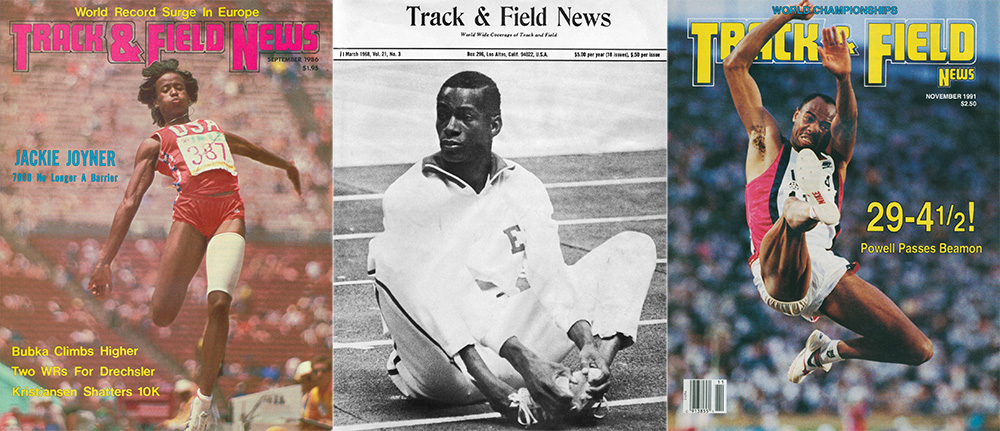
ARE FOULS killing the long jump? That’s the notion behind a recently announced WA plan to experiment with a new format for the event, measuring each attempt from where a jumper actually takes off, so long as it is within a designated jump zone.
“That means every single jump counts. It adds to the jeopardy and drama in the competition,” said World Athletics CEO Jon Ridgeon.
The move was motivated by data from last summer’s WC that showed that a third of the attempts ended in fouls and run-throughs. That makes it challenging for live broadcasters to present the event, with a quick cutaway from a running event to the long jump runway often ending in an anticlimactic foul.
Added Ridgeon, “We’ll spend this year testing it in real-life circumstances with very good athletes. If it doesn’t pass testing, we’ll never introduce it. At the same time, we’re working out ways we can get instant results so you don’t have to wait 20–30 seconds before the result pops up.”
The proposal may also lengthen jump results, as no longer would someone be leaving the ground X centimeters before the line. And while no one seems to have mentioned the triple jump, it’s safe to assume that if WA decides the new format is a winner, it will be applied there also.
Predictably, plenty of long jump greats sounded off along the lines of “if it ain’t broke…”
The objection that got the most air time came from Greece’s Olympic champion, Miltiádis Tentóglou, who was asked about it right after winning the World Indoor title. “I consider long jump to be one of the hardest events because of the board and the accuracy you need,” he said. “You need to run like a sprinter, to hit the board perfectly — this is the difficult part of the long jump. The jump itself is easy. The hard part is the runup.
“So if they want to remove this, the long jump would be the easiest event. If that happens, I will not do long jump anymore. I will be a triple jumper.”
Said ’23 world champion Ivana Španović, “The biggest problem is that the people who change the rules of this sport are precisely the people who have never had any contact with this sport. You change the rules of the game without consulting those who make the sport exist. You ignore their view, you don’t respect their opinion, and you ignore the problems that cause them to get injured.”
Calling the proposal an “April Fool’s joke,” all-time great Carl Lewis tweeted, “The issue has nothing to do with fouling. They are no longer trying to jump far. We jumped differently. That’s why we jumped farther. So the board change will hurt the distances in the long run. A lack of discipline and consistency on the runway that exists will only get worse… You would just see more bad jumps measured.”
Tianna Madison, ’16 Olympic gold medalist and 2-time world champion, wrote a blog on the decision makers and the process behind the proposal, saying, “Instead of say, taking the time to teach viewers about the event… they decide to introduce increasingly obscure rules to muddy the waters further. They then turn around and say, ‘see viewership is down.’ A self-perpetuated, self-fulfilling fallacy.”
Dwight Phillips, himself the ’04 Olympic winner and 4-time world champ, said, “The athletes are speaking but nobody is listening. This change will be so confusing and opens the door for ambiguous marking. The fans will have zero context for how far each individual is jumping because now the meter markings on the side will be irrelevant.”
Not all voices have been opposed. British TV commentator Tim Hutchings responded by posting, “‘Simply the person who jumps the furthest will win.’” — now there’s a novelty…! Many traditionalists (& I suspect most of the long jump fraternity?) won’t like this. But it’s a user-friendly advancement, that [should] attract/retain more fans. Some events needs to adapt, or whither.”
Historians note that the idea has bounced around before. The late Roberto Quercetani wrote in our pages that in ’61, the IAAF invited federations to experiment with using a 1-meter takeoff zone. “Jumpers would be ‘psychologically unbothered’ while going down the runway and there would be practically no fouls. For those two reasons it can easily be predicted that broad jump marks would improve considerably.” The idea did not take off back then.
This time around, WA head Seb Coe is standing firm, saying, “The holy grail of every sport is to remain salient, interesting, exciting to young people. We have can’t have a tin ear in their direction. We have to recognize that the way people consume sport — the way they consume entertainment — is different than it was even three years ago.”